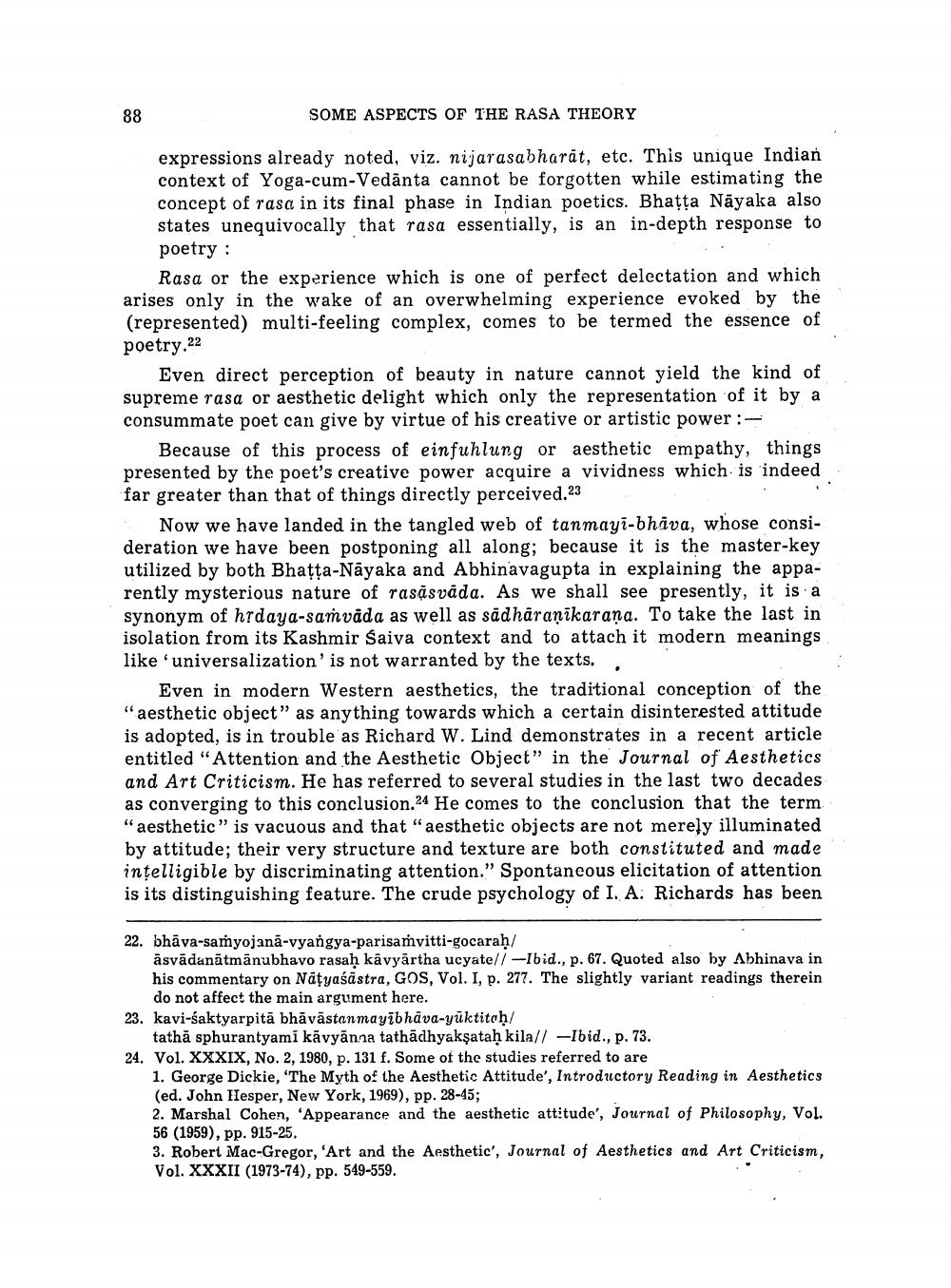________________
88
SOME ASPECTS OF THE RASA THEORY
expressions already noted, viz. nijarasabharat, etc. This unique Indian context of Yoga-cum-Vedānta cannot be forgotten while estimating the concept of rasa in its final phase in Indian poetics. Bhatta Nāyaka also states unequivocally that rasa essentially, is an in-depth response to poetry :
Rasa or the experience which is one of perfect delectation and which arises only in the wake of an overwhelming experience evoked by the (represented) multi-feeling complex, comes to be termed the essence of poetry.22
Even direct perception of beauty in nature cannot yield the kind of supreme rasa or aesthetic delight which only the representation of it by a consummate poet can give by virtue of his creative or artistic power :
Because of this process of einfuhlung or aesthetic empathy, things presented by the poet's creative power acquire a vividness which is indeed far greater than that of things directly perceived.23
Now we have landed in the tangled web of tanmayi-bhava, whose consideration we have been postponing all along; because it is the master-key utilized by both Bhatta-Nayaka and Abhinavagupta in explaining the apparently mysterious nature of rasāsvāda. As we shall see presently, it is a synonym of hrdaya-samvada as well as sådhāraṇikarana. To take the last in isolation from its Kashmir Saiya context and to attach it modern meanings like 'universalization' is not warranted by the texts.,
Even in modern Western aesthetics, the traditional conception of the "aesthetic object" as anything towards which a certain disinterested attitude is adopted, is in trouble as Richard W. Lind demonstrates in a recent article entitled "Attention and the Aesthetic Object" in the Journal of Aesthetics and Art Criticism. He has referred to several studies in the last two decades as converging to this conclusion.24 He comes to the conclusion that the term "aesthetic" is vacuous and that "aesthetic objects are not merely illuminated by attitude; their very structure and texture are both constituted and made intelligible by discriminating attention." Spontaneous elicitation of attention is its distinguishing feature. The crude psychology of I. A. Richards has been
22. bhāva-samyojana-vyangya-parisamvitti-gocaraḥ/
āsvādanātmānubhavo rasah kavyārtha ucyatel/-Ibid., p. 67. Quoted also by Abhinava in his commentary on Näțyaśāstra, GOS, Vol. I, p. 277. The slightly variant readings therein
do not affect the main argument here. 23. kavi-saktyarpitā bhāvāstanmayabhāva-yūktitch/
tathā sphurantyami kāvyānna tathādhyakşataḥ kila// -Ibid., p. 73. 24. Vol. XXXIX, No. 2, 1980, p. 131 f. Some of the studies referred to are
1. George Dickie, 'The Myth of the Aesthetic Attitude', Introductory Reading in Aesthetics (ed. John Hesper, New York, 1969), pp. 28-45; 2. Marshal Cohen, 'Appearance and the aesthetic attitude', Journal of Philosophy, Vol. 56 (1959), pp. 915-25. 3. Robert Mac-Gregor, 'Art and the Aesthetic', Journal of Aesthetics and Art Criticism, Vol. XXXII (1973-74), pp. 549-559.




